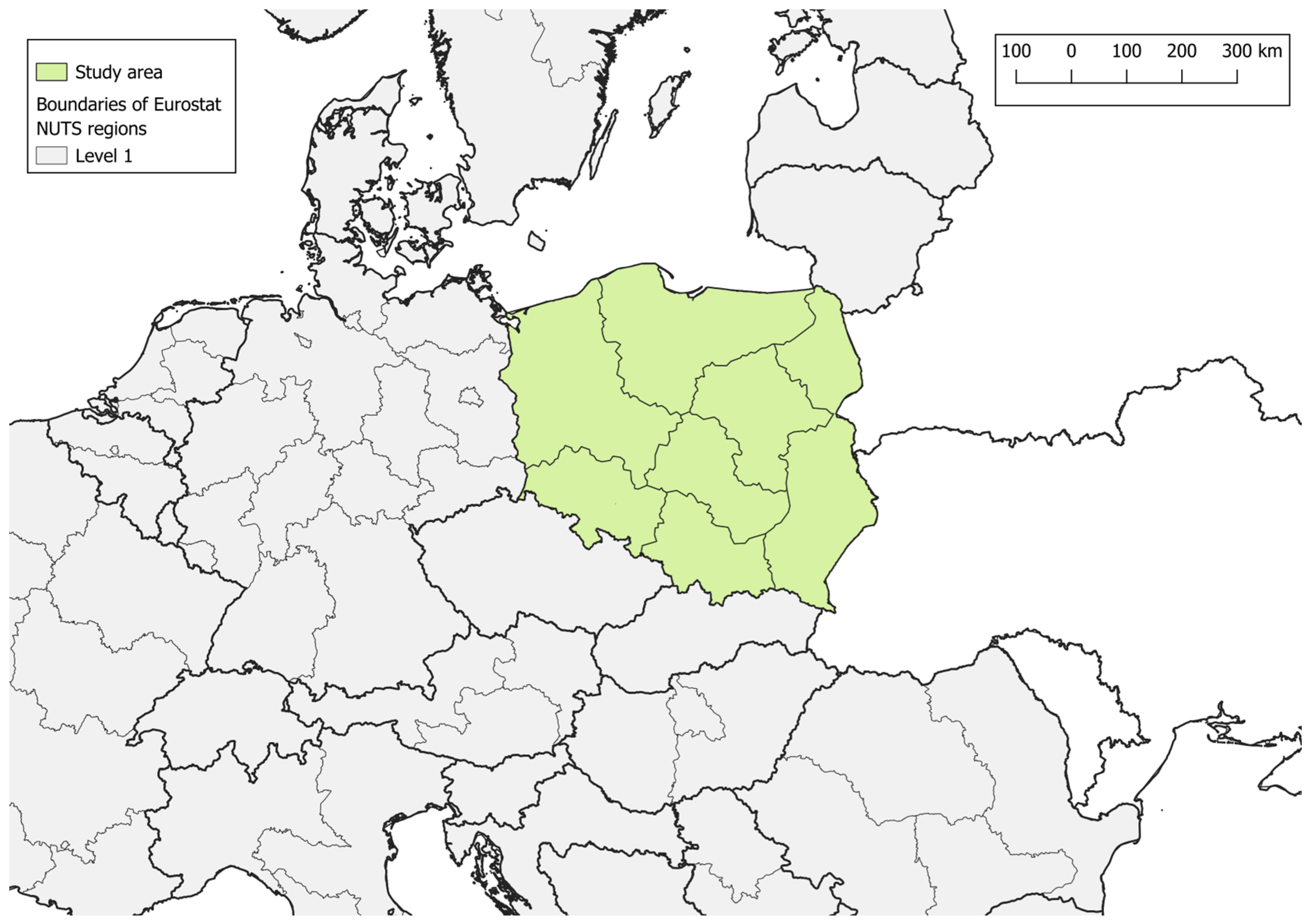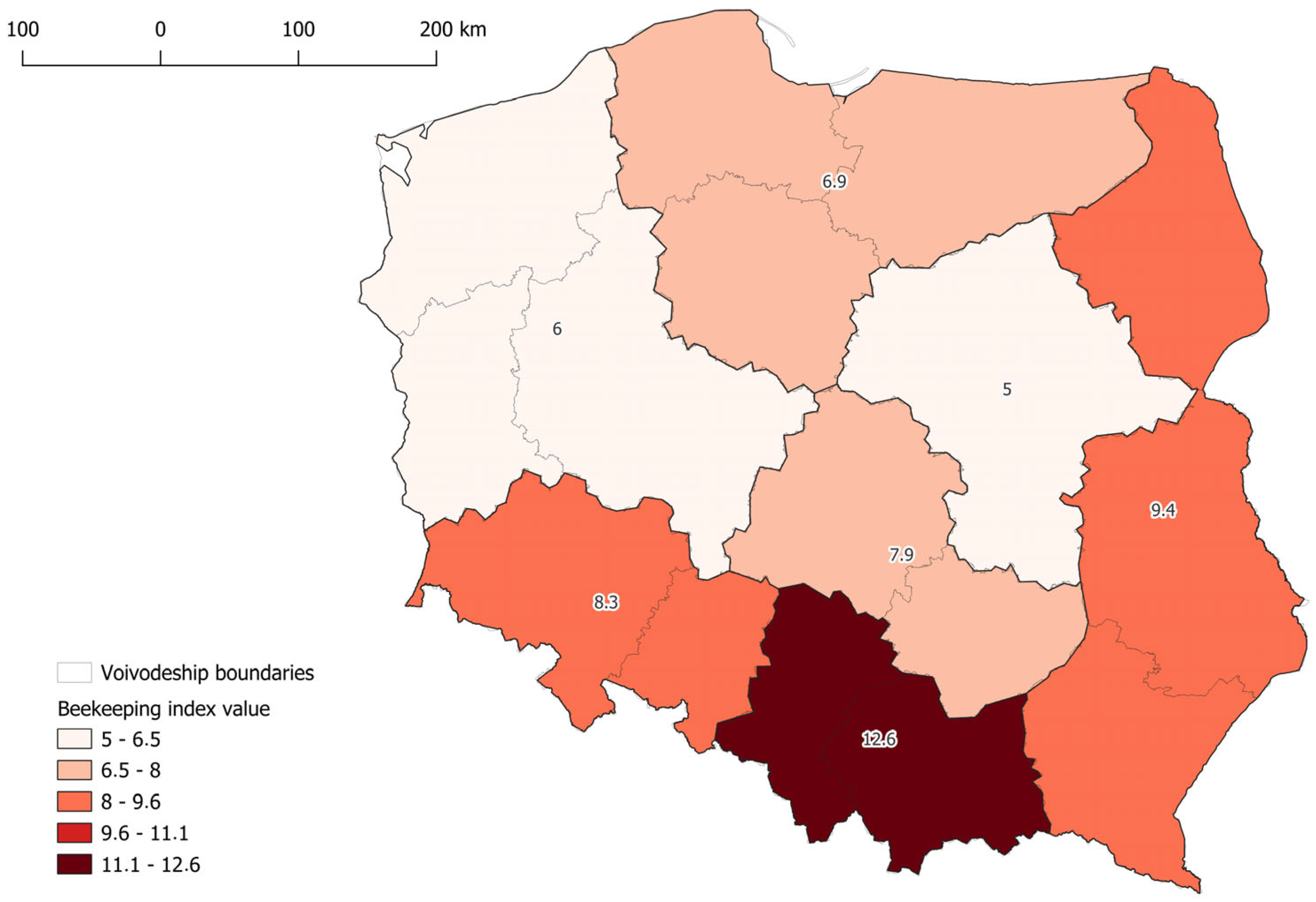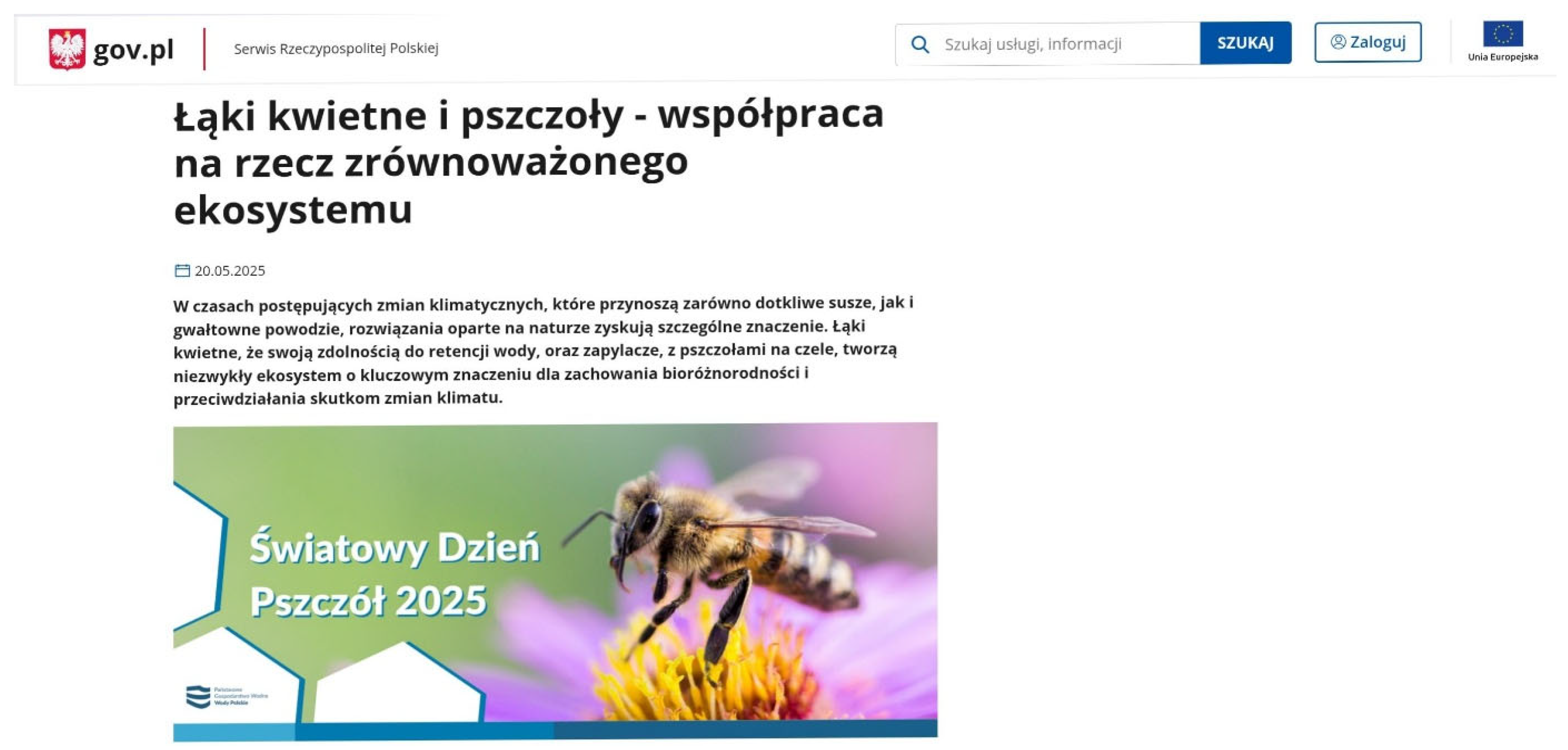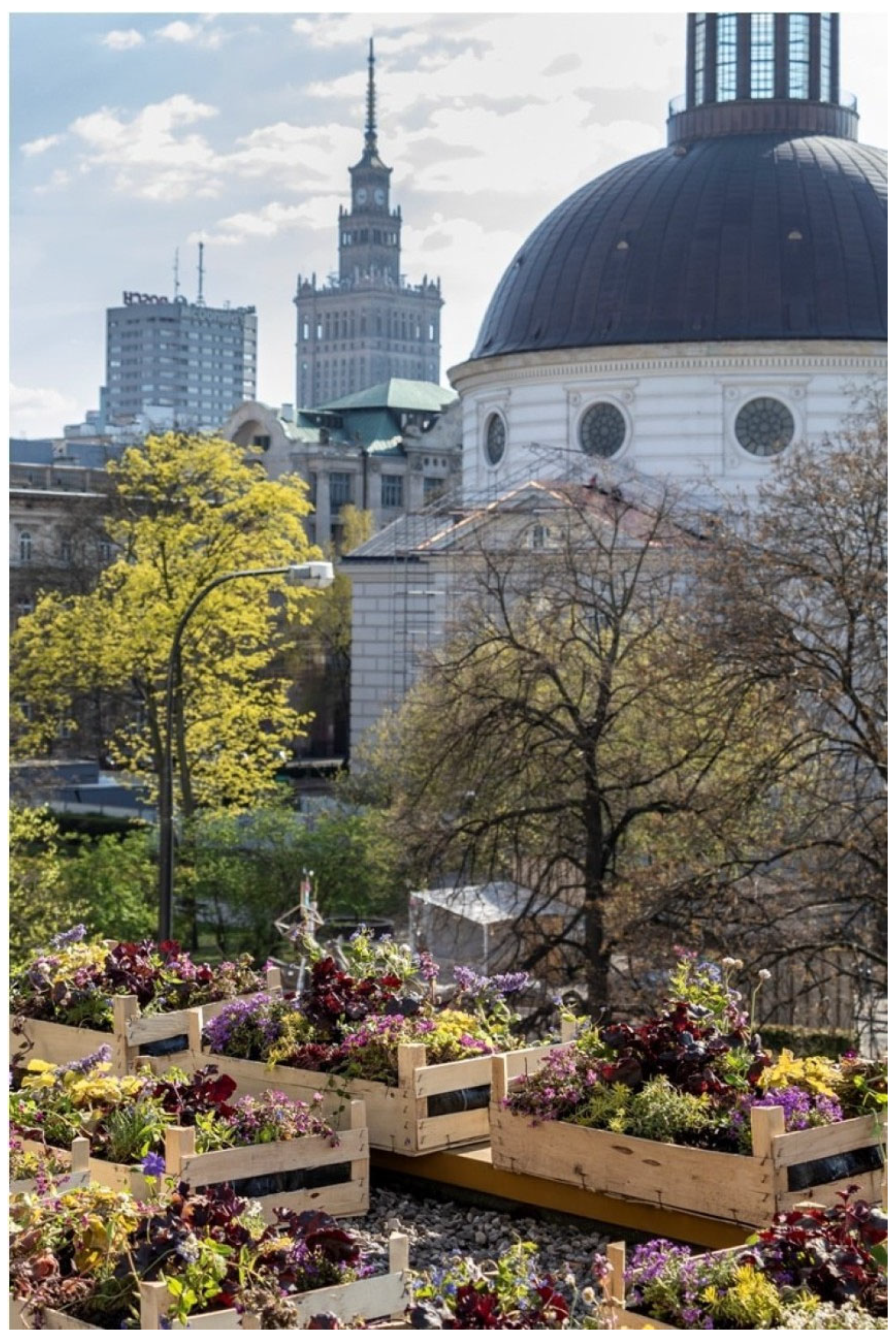Sustainable Cities and Biodiversity Protection—The Case of Pollinators: An Analysis of the Bee Density Index in Macroregions of Poland
Abstract
1. Introduction
2. Materials and Methods
2.1. Study Area
2.2. Field Research
3. Results and Discussion
4. Conclusions
5. Limitations
Author Contributions
Funding
Institutional Review Board Statement
Informed Consent Statement
Data Availability Statement
Conflicts of Interest
References
- Ollerton, J.; Winfree, R.; Tarrant, S. How Many Flowering Plants Are Pollinated by Animals? Oikos 2011, 120, 321–326. [Google Scholar] [CrossRef]
- Feketéné Ferenczi, A.; Szűcs, I.; Bauerné Gáthy, A. Evaluation of the Pollination Ecosystem Service of the Honey Bee (Apis mellifera) Based on a Beekeeping Model in Hungary. Sustainability 2023, 15, 9906. [Google Scholar] [CrossRef]
- Potts, S.G. The Assessment Report on Pollinators, Pollination and Food Production: Summary for Policymakers; Secretariat of the Intergovernmental Science-Policy Platform on Biodiversity and Ecosystem Services: Bonn, Germany, 2016; ISBN 978-92-807-3568-0. [Google Scholar]
- Wietzke, A.; Westphal, C.; Gras, P.; Kraft, M.; Pfohl, K.; Karlovsky, P.; Pawelzik, E.; Tscharntke, T.; Smit, I. Insect Pollination as a Key Factor for Strawberry Physiology and Marketable Fruit Quality. Agric. Ecosyst. Environ. 2018, 258, 197–204. [Google Scholar] [CrossRef]
- Bartomeus, I. Understanding Linkage Rules in Plant-Pollinator Networks by Using Hierarchical Models That Incorporate Pollinator Detectability and Plant Traits. PLoS ONE 2013, 8, e69200. [Google Scholar] [CrossRef]
- Garibaldi, L.A.; Steffan-Dewenter, I.; Winfree, R.; Aizen, M.A.; Bommarco, R.; Cunningham, S.A.; Kremen, C.; Carvalheiro, L.G.; Harder, L.D.; Afik, O.; et al. Wild Pollinators Enhance Fruit Set of Crops Regardless of Honey Bee Abundance. Science 2013, 339, 1608–1611. [Google Scholar] [CrossRef]
- Drummond, F.A.; Hoshide, A.K. An Economic Cost/Benefit Tool to Assess Bee Pollinator Conservation, Pollination Strategies, and Sustainable Policies: A Lowbush Blueberry Case Study. Sustainability 2024, 16, 3242. [Google Scholar] [CrossRef]
- LeBuhn, G.; Luna, J.V. Pollinator Decline: What Do We Know about the Drivers of Solitary Bee Declines? Curr. Opin. Insect Sci. 2021, 46, 106–111. [Google Scholar] [CrossRef] [PubMed]
- Brunet, J.; Fragoso, F.P. What Are the Main Reasons for the Worldwide Decline in Pollinator Populations? CABI Rev. 2024, 19. [Google Scholar] [CrossRef]
- Chen, Y.; Liu, Y.; Zhao, C.; Ma, J.; Guo, J. Antibiotic Resistance Gene Pollution in Poultry Farming Environments and Approaches for Mitigation: A System Review. Poult. Sci. 2025, 104, 104858. [Google Scholar] [CrossRef]
- European Court of Auditors. Protection of Wild Pollinators in the EU: Commission Initiatives Have Not Borne Fruit; Special Report No 15, 2020; Publications Office: Luxembourg, 2020. [Google Scholar]
- Main, A.R.; Webb, E.B.; Goyne, K.W.; Mengel, D. Neonicotinoid Insecticides Negatively Affect Performance Measures of Non-target Terrestrial Arthropods: A Meta-analysis. Ecol. Appl. 2018, 28, 1232–1244. [Google Scholar] [CrossRef]
- Jeschke, P.; Nauen, R.; Schindler, M.; Elbert, A. Overview of the Status and Global Strategy for Neonicotinoids. J. Agric. Food Chem. 2011, 59, 2897–2908. [Google Scholar] [CrossRef]
- Chattopadhyay, A.; Samadder, A.; Bhattacharya, S. Pesticide Mediated Critical Transition in Plant-Pollinator Networks. arXiv 2023, arXiv:2303.08495. [Google Scholar]
- Sampson, B.; Gregorc, A.; Alburaki, M.; Werle, C.; Karim, S.; Adamczyk, J.; Knight, P. Sensitivity to Imidacloprid Insecticide Varies among Some Social and Solitary Bee Species of Agricultural Value. PLoS ONE 2023, 18, e0285167. [Google Scholar] [CrossRef] [PubMed]
- Tarbill, G.L.; White, A.M.; Sollmann, R. Floral Richness Drives Pollinator Diversity after Fire in Upland Forests and Meadows of the Sierra Nevada, California. Insect Conserv. Divers. 2024, 17, 869–883. [Google Scholar] [CrossRef]
- Vujanović, D.; Losapio, G.; Mészáros, M.; Popov, S.; Markov Ristić, Z.; Mudri Stojnić, S.; Jović, J.; Vujić, A. Forest and Grassland Habitats Support Pollinator Diversity More than Wildflowers and Sunflower Monoculture. Ecol. Entomol. 2023, 48, 421–432. [Google Scholar] [CrossRef]
- Gatunki Obce i Inwazyjne. Available online: https://www.iop.krakow.pl/ias/gatunki (accessed on 18 July 2025).
- Hallmann, C.A.; Sorg, M.; Jongejans, E.; Siepel, H.; Hofland, N.; Schwan, H.; Stenmans, W.; Müller, A.; Sumser, H.; Hörren, T.; et al. More than 75 Percent Decline over 27 Years in Total Flying Insect Biomass in Protected Areas. PLoS ONE 2017, 12, e0185809. [Google Scholar] [CrossRef]
- Valtonen, A.; Hirka, A.; Szőcs, L.; Ayres, M.P.; Roininen, H.; Csóka, G. Long-term Species Loss and Homogenization of Moth Communities in Central Europe. J. Anim. Ecol. 2017, 86, 730–738. [Google Scholar] [CrossRef]
- Conrad, K.F.; Warren, M.S.; Fox, R.; Parsons, M.S.; Woiwod, I.P. Rapid Declines of Common, Widespread British Moths Provide Evidence of an Insect Biodiversity Crisis. Biol. Conserv. 2006, 132, 279–291. [Google Scholar] [CrossRef]
- Van Strien, A.J.; Van Swaay, C.A.M.; Van Strien-van Liempt, W.T.F.H.; Poot, M.J.M.; WallisDeVries, M.F. Over a Century of Data Reveal More than 80% Decline in Butterflies in the Netherlands. Biol. Conserv. 2019, 234, 116–122. [Google Scholar] [CrossRef]
- Sánchez-Bayo, F.; Wyckhuys, K.A.G. Worldwide Decline of the Entomofauna: A Review of Its Drivers. Biol. Conserv. 2019, 232, 8–27. [Google Scholar] [CrossRef]
- Wagner, D.L. Insect Declines in the Anthropocene. Annu. Rev. Entomol. 2020, 65, 457–480. [Google Scholar] [CrossRef]
- Kehoe, R.; Frago, E.; Sanders, D. Cascading Extinctions as a Hidden Driver of Insect Decline. Ecol. Entomol. 2021, 46, 743–756. [Google Scholar] [CrossRef]
- Colla, S.R. The Potential Consequences of ‘Bee Washing’ on Wild Bee Health and Conservation. Int. J. Parasitol. Parasites Wildl. 2022, 18, 30–32. [Google Scholar] [CrossRef]
- Piot, N.; Schweiger, O.; Meeus, I.; Yañez, O.; Straub, L.; Villamar-Bouza, L.; De La Rúa, P.; Jara, L.; Ruiz, C.; Malmstrøm, M.; et al. Honey Bees and Climate Explain Viral Prevalence in Wild Bee Communities on a Continental Scale. Sci. Rep. 2022, 12, 1904. [Google Scholar] [CrossRef] [PubMed]
- Główny Urząd Statystyczny. Rocznik Statystyczny Województw 2024; Główny Urząd Statystyczny: Warsaw, Poland, 2024; p. 253. [Google Scholar]
- European Commission. Market Presentation—Honey—Spring 2024; Directorate-General for Agriculture and Rural Development: Brussels, Belgium, 2024. [Google Scholar]
- Testa, R.; Asciuto, A.; Schifani, G.; Schimmenti, E.; Migliore, G. Quality Determinants and Effect of Therapeutic Properties in Honey Consumption. An Exploratory Study on Italian Consumers. Agriculture 2019, 9, 174. [Google Scholar] [CrossRef]
- Kowalczuk, I.; Gębski, J.; Stangierska, D.; Szymańska, A. Determinants of Honey and Other Bee Products Use for Culinary, Cosmetic, and Medical Purposes. Nutrients 2023, 15, 737. [Google Scholar] [CrossRef] [PubMed]
- Šedík, P.; Hudecová, M.; Predanócyová, K. Exploring Consumers’ Preferences and Attitudes to Honey: Generation Approach in Slovakia. Foods 2023, 12, 1941. [Google Scholar] [CrossRef]
- Pawłowska-Tyszko, J.; Jarka, S.; Olech, I. Food Self-Sufficiency in the Honey Market in Poland. Sustainability 2024, 16, 9373. [Google Scholar] [CrossRef]
- Al-Ghamdi, A.; Adgaba, N.; Getachew, A.; Tadesse, Y. New Approach for Determination of an Optimum Honeybee Colony’s Carrying Capacity Based on Productivity and Nectar Secretion Potential of Bee Forage Species. Saudi J. Biol. Sci. 2016, 23, 92–100. [Google Scholar] [CrossRef]
- Semkiw, P. Sektor Pszczelarski w Polsce w 2014 Roku; InHort Skierniewice, Instytut Ogrodnictwa Zakład Pszczelnictwa w Puławach: Puławy, Poland, 2014; pp. 1–14. [Google Scholar]
- Semkiw, P. Sektor Pszczelarski w Polsce w 2016 Roku; InHort Skierniewice, Instytut Ogrodnictwa Zakład Pszczelnictwa w Puławach: Puławy, Poland, 2016; pp. 1–12. [Google Scholar]
- Semkiw, P.; Skubida, P.; Jeziorski, K.; Pioś, A. Sektor Pszczelarski w Polsce w 2018 Roku; InHort Skierniewice, Instytut Ogrodnictwa Zakład Pszczelnictwa w Puławach: Puławy, Poland, 2018; pp. 1–12. [Google Scholar]
- Semkiw, P. Sektor Pszczelarski w Polsce w 2020 Roku; InHort Skierniewice, Instytut Ogrodnictwa Zakład Pszczelnictwa w Puławach: Puławy, Poland, 2020; pp. 1–13. [Google Scholar]
- Semkiw, P. Stan Pszczelarstwa w Polsce w 2023 Roku; InHort Skierniewice Instytut Ogrodnictwa—PIB: Puławy, Poland; Ministerstwo Rolnictwa i Rozwoju Wsi: Warsaw, Poland, 2023; pp. 1–14. [Google Scholar]
- Semkiw, P. Stan Pszczelarstwa w Polsce w 2024 Roku; InHort Skierniewice Instytut Ogrodnictwa—PIB: Puławy, Poland; Ministerstwo Rolnictwa i Rozwoju Wsi: Warsaw, Poland, 2024; pp. 1–10. [Google Scholar]
- Smęder, M. Aspekty Ekonomiczne Gospodarowania ROD. Available online: https://pzd.pl/artykuly/12979/108/Aspekty-ekonomiczne-gospodarowania-ROD.html (accessed on 24 June 2025).
- Urząd Miasta Poznania/Poznań.pl Poznań dla Ogródków Działkowych. Available online: https://www.poznan.pl/mim/info/news/poznan-dla-ogrodkow-dzialkowych,225018.html (accessed on 2 July 2025).
- Wydział Rozwoju Miasta i Współpracy Międzynarodowej Urzędu Miasta Poznania. Raport o Stanie Miasta Poznania za Rok 2024; Urząd Miasta Poznania: Poznań, Poland, 2024; p. 219. [Google Scholar]
- Geoportal Wrocław Charakterystyka Obszaru Podlegającego Ocenie; Geoportal Wrocław. Available online: https://geoportal.wroclaw.pl/ (accessed on 13 July 2025).
- Urząd Miasta Wrocławia. Raport o Stanie Gminy 2024; Urząd Miasta Wrocławia: Wrocław, Poland, 2024; p. 292. [Google Scholar]
- Wiązowska, K. Wielki Boom na Ogródki Działkowe w Mieście. Available online: https://www.wroclaw.pl/dla-mieszkanca/ogrody-dzialkowe-wroclaw (accessed on 3 July 2025).
- Urząd Miejski w Gdańsku/Gdańskie Centrum Multimedialne Ogólna Charakterystyka Miasta—Raport o Stanie Miasta Gdańska 2023. Available online: https://bip.gdansk.pl/urzad-miejski/raporty-i-publikacje/Raport-o-stanie-miasta-Gdanska-za-2023-rok,a,264665 (accessed on 13 July 2025).
- Urząd Miejski w Gdańsku. Raport o Stanie Miasta Gdańska za 2024 Rok; Urząd Miasta Gdańska: Gdańsk, Poland, 2025; p. 308. [Google Scholar]
- Urząd Miasta Łodzi Łódź w Pigułce. Available online: https://uml.lodz.pl/dla-mieszkancow/o-miescie/lodz-w-pigulce/ (accessed on 11 July 2025).
- Urząd Miasta Łodzi—Departament Strategii i Promorcji, Biuro Strategii Miasta. Łódź 2024. Raport o Stanie Miasta; Urząd Miasta Łodzi: Łódź, Poland, 2025; p. 122. [Google Scholar]
- Szkup, R.; Pytel, S. Rodzinne Ogrody Działkowe (ROD) w przestrzeni dużego miasta przykład Łodzi. Pr. Kom. Kraj. Kult. 2016, 32, 109–124. [Google Scholar]
- Urząd Miasta Rzeszowa. Raport o Stanie Miasta Rzeszowa za 2023 Rok; Urząd Miasta Rzeszowa: Rzeszów, Poland, 2025; pp. 1–134. [Google Scholar]
- Rzeszów w Liczbach. Available online: http://erzeszow.pl/41-miasto-rzeszow/1757-dane-statystyczne.html (accessed on 20 June 2025).
- Urząd Miasta Rzeszowa. Raport o Stanie Miasta Rzeszowa za 2024 Rok; Urząd Miasta Rzeszowa: Rzeszów, Poland, 2025; pp. 1–158. [Google Scholar]
- Urząd Miasta Warszawa, Biuro Strategii i Analiz Urzędu m.st. Warszawy. Raport o Stanie Miasta Warszawa 2024; Urząd Miasta Warszawa: Warsaw, Poland, 2025; pp. 1–186. [Google Scholar]
- Polski Związek Działkowców Ogrody Działkowe w Europie. Available online: https://pzd.pl/archiwum/strona.php?4073 (accessed on 15 July 2025).
- Gatti, L.; Conti, L.G.; Seele, P. A Comprehensive Guide to Greenwashing Phenomena, Contexts, and Trends: The Mean, Lean Washing Machine; Edward Elgar Publishing: Cheltenham, UK, 2025; ISBN 978-1-0353-2824-6. [Google Scholar]
- Wiseman, L.; Rawson, R.; Okere, U.V. Bee-Friendly Interventions: The Barriers and Opportunities Affecting Urban Residents’ Conservation of Wild Bees in Gardens. J. Insect Conserv. 2025, 29, 7. [Google Scholar] [CrossRef]
- Pasterczyk, J. Pierwsza Miejska Pasieka Powstała na Dachu Galerii Rzeszów. Pszczoły Będą Zapylać Kwiaty w Promieniu 3 km. Available online: https://rzeszow.wyborcza.pl/rzeszow/7,34962,26183064,pierwsza-miejska-pasieka-powstala-na-dachu-galerii-rzeszow.html (accessed on 7 August 2025).
- MPWiK Sp. z o.o. Miejskie Pszczoły z Pasieki MPWiK nie Próżnują. Wyprodukowały Ponad 140 Kilogramów Miodu—MPWiK Sp. z o.o. Available online: https://mpwik.rzeszow.pl/miejskie-pszczoly-z-pasieki-mpwik-nie-proznuja-wyprodukowaly-ponad-140-kilogramow-miodu/ (accessed on 7 August 2025).
- Postrzednik, J. Ogrody na Dachach Hoteli. Mnóstwo Kwiatów ma Ocalić Warszawskie Pszczoły od Wyginięcia. Available online: https://warszawa.naszemiasto.pl/ogrody-na-dachach-hoteli-mnostwo-kwiatow-ma-ocalic/ar/c8-5100941 (accessed on 7 August 2025).
- Ruszył Ogólnopolski Projekt na Rzecz Ochrony Zapylaczy w Sadach. Available online: https://www.sadyogrody.pl/agrotechnika/103/ruszyl_ogolnopolski_projekt_na_rzecz_ochrony_zapylaczy_w_sadach,47675.html (accessed on 7 August 2025).
- Bassi, M.I.E.; Staude, I.R. Insects decline with host plants but coextinctions may be limited. Proc. Natl. Acad. Sci. USA 2024, 121, e2417408121. [Google Scholar] [CrossRef] [PubMed]
- Sadowska, M.; Gogolewska, H.; Pawelec, N.; Sentkowska, A.; Krasnodębska-Ostręga, B. Comparison of the Contents of Selected Elements and Pesticides in Honey Bees with Regard to Their Habitat. Environ. Sci. Pollut. Res. 2019, 26, 371–380. [Google Scholar] [CrossRef]
- Nicewicz, A.W.; Nicewicz, Ł.; Pawłowska, P. Antioxidant Capacity of Honey from the Urban Apiary: A Comparison with Honey from the Rural Apiary. Sci. Rep. 2021, 11, 9695. [Google Scholar] [CrossRef]
- Zaninotto, V.; Thebault, E.; Dajoz, I. Native and Exotic Plants Play Different Roles in Urban Pollination Networks across Seasons. Oecologia 2023, 201, 525–536. [Google Scholar] [CrossRef] [PubMed]
- Siviter, H.; Pardee, G.L.; Baert, N.; McArt, S.; Jha, S.; Muth, F. Wild Bees Are Exposed to Low Levels of Pesticides in Urban Grasslands and Community Gardens. Sci. Total Environ. 2023, 858, 159839. [Google Scholar] [CrossRef]
- Quinton, A. Pesticides Can Affect Multiple Generations of Bees. Study Finds Reduced Bee Reproduction over 2 Years. Available online: https://www.ucdavis.edu/climate/news/pesticides-can-affect-multiple-generations-bees (accessed on 5 September 2025).
- Lerman, S.B.; Contosta, A.R.; Milam, J.; Bang, C. To Mow or to Mow Less: Lawn Mowing Frequency Affects Bee Abundance and Diversity in Suburban Yards. Biol. Conserv. 2018, 221, 160–174. [Google Scholar] [CrossRef]
- Morrison, M.; Bright, A.; Brown, M.J.F. Reduced Mowing Frequencies Increase Pollinator Abundance in Urban Lawns in the UK. Conserv. Evid. J. 2025, 22, 1–8. [Google Scholar] [CrossRef]
- Dusza, Y.; Kraepiel, Y.; Abbadie, L.; Barot, S.; Carmignac, D.; Dajoz, I.; Gendreau, E.; Lata, J.-C.; Meriguet, J.; Motard, E.; et al. Plant-Pollinator Interactions on Green Roofs Are Mediated by Substrate Characteristics and Plant Community Composition. Acta Oecol. 2020, 105, 103559. [Google Scholar] [CrossRef]
- Jacobs, J.; Beenaerts, N.; Artois, T. Green Roofs and Pollinators, Useful Green Spots for Some Wild Bee Species (Hymenoptera: Anthophila), but Not so Much for Hoverflies (Diptera: Syrphidae). Sci. Rep. 2023, 13, 1449. [Google Scholar] [CrossRef]
- Pokorny, K.; Branam, C. Native Plants Attract More Pollinators than Cultivars in OSU Study. Available online: https://extension.oregonstate.edu/news/native-plants-attract-more-pollinators-cultivars-osu-study (accessed on 6 September 2025).
- Marcacci, G.; Devy, S.; Wenzel, A.; Rao, V.S.; Kumar, S.S.; Nölke, N.; Belavadi, V.V.; Tscharntke, T.; Grass, I.; Westphal, C. Direct and Indirect Effects of Urbanization, Pesticides and Wild Insect Pollinators on Mango Yield. J. Appl. Ecol. 2023, 60, 2132–2143. [Google Scholar] [CrossRef]
- Geslin, B.; Gachet, S.; Deschamps-Cottin, M.; Flacher, F.; Ignace, B.; Knoploch, C.; Meineri, É.; Robles, C.; Ropars, L.; Schurr, L.; et al. Bee Hotels Host a High Abundance of Exotic Bees in an Urban Context. Acta Oecol. 2020, 105, 103556. [Google Scholar] [CrossRef]
- MacIvor, J.S.; Packer, L. ‘Bee Hotels’ as Tools for Native Pollinator Conservation: A Premature Verdict? PLoS ONE 2015, 10, e0122126. [Google Scholar] [CrossRef]
- Prendergast, K.S.; Wilson, R.S. Bee Hotels as a Tool for Post-Fire Recovery of Cavity-Nesting Native Bees. Insects 2025, 16, 659. [Google Scholar] [CrossRef]
- Rahimi, E.; Barghjelveh, S.; Dong, P. How Effective Are Artificial Nests in Attracting Bees? A Review. J. Ecol. Environ. 2021, 45, 16. [Google Scholar] [CrossRef]
- Herrmann, J.; Buchholz, S.; Theodorou, P. The Degree of Urbanisation Reduces Wild Bee and Butterfly Diversity and Alters the Patterns of Flower-Visitation in Urban Dry Grasslands. Sci. Rep. 2023, 13, 2702. [Google Scholar] [CrossRef]
- Liang, H.; He, Y.; Theodorou, P.; Yang, C. The Effects of Urbanization on Pollinators and Pollination: A Meta-analysis. Ecol. Lett. 2023, 26, 1629–1642. [Google Scholar] [CrossRef]
- Vanbergen, A.J.; Espíndola, A.; Aizen, M.A. Risks to Pollinators and Pollination from Invasive Alien Species. Nat. Ecol. Evol. 2017, 2, 16–25. [Google Scholar] [CrossRef] [PubMed]
- Kovács-Hostyánszki, A.; Szigeti, V.; Miholcsa, Z.; Sándor, D.; Soltész, Z.; Török, E.; Fenesi, A. Threats and Benefits of Invasive Alien Plant Species on Pollinators. Basic Appl. Ecol. 2022, 64, 89–102. [Google Scholar] [CrossRef]
- Liang, C.T.; Shiels, A.B.; Haines, W.P.; Sandor, M.E.; Aslan, C.E. Invasive Predators Affect Community-wide Pollinator Visitation. Ecol. Appl. 2022, 32, e2522. [Google Scholar] [CrossRef]
- Iwasaki, J.M.; Hogendoorn, K. Mounting Evidence That Managed and Introduced Bees Have Negative Impacts on Wild Bees: An Updated Review. Curr. Res. Insect Sci. 2022, 2, 100043. [Google Scholar] [CrossRef]
- MacInnis, G.; Normandin, E.; Ziter, C.D. Decline in Wild Bee Species Richness Associated with Honey Bee (Apis mellifera L.) Abundance in an Urban Ecosystem. PeerJ 2023, 11, e14699. [Google Scholar] [CrossRef]
- Mallinger, R.E.; Gaines-Day, H.R.; Gratton, C. Do Managed Bees Have Negative Effects on Wild Bees?: A Systematic Review of the Literature. PLoS ONE 2017, 12, e0189268. [Google Scholar] [CrossRef]
- Quinlan, G.M.; Doser, J.W.; Kammerer, M.A.; Grozinger, C.M. Estimating Genus-Specific Effects of Non-Native Honey Bees and Urbanization on Wild Bee Communities: A Case Study in Maryland, United States. Sci. Total Environ. 2024, 953, 175783. [Google Scholar] [CrossRef]
- Ayala-Azcarraga, C.; Hinojosa-Diaz, I.A.; Segura, O.; Pacheco-Muñoz, R.; Larrucea-Garritz, A.; Diaz, D. Evaluation of Sustainable Landscape Design: Presence of Native Pollinators in an Urban Park in Mexico City, Mexico. Sustainability 2025, 17, 799. [Google Scholar] [CrossRef]
- Sabbahi, R.; El Abdouni, I.; Lhomme, P.; Boubker, O.; Azzaoui, K.; Hammouti, B.; Neffa, M.; Hock, V. Public Attitudes towards Insect Pollinators in Morocco: Insights from a Pilot Study with Broader Applications. Diversity 2024, 16, 383. [Google Scholar] [CrossRef]
- Pollinator Strategy | The Royal Parks. Available online: https://www.royalparks.org.uk/park-management/park-strategies/pollinator-strategy (accessed on 8 September 2025).
- Initial Study for Bee Ecological Spatial Planning in Vienna—BOKU FIS. Available online: https://forschung.boku.ac.at/en/projects/15634 (accessed on 8 September 2025).
- Dzyr, A. Spotkanie Grupy ds. Zapylaczy w Warszawie. Available online: https://www.umcs.pl/pl/aktualnosci,17728,spotkanie-grupy-ds-zapylaczy-w-warszawie,163954.chtm (accessed on 15 May 2025).
- Bruno, E.; Falco, E.; Geneletti, D. Combining Demand for Ecosystem Services with Ecosystem Conditions of Vacant Lots to Support Land Preservation and Restoration Decisions. Sustainability 2025, 17, 4686. [Google Scholar] [CrossRef]





| NUTS-1 in Poland | Voivodeships in Poland |
|---|---|
| Southern | Małopolskie, Śląskie |
| North-Western | Zachodniopomorskie, Lubuskie, Wielkopolskie |
| South-Western | Dolnośląskie, Opolskie |
| Northern | Pomorskie, Warmińsko-Mazurskie, Kujawsko-Pomorskie |
| Central | Łódzkie, Świętokrzyskie |
| Eastern | Podlaskie, Lubelskie, Podkarpackie |
| Mazowieckie Voivodeship | Mazowieckie |
| Macroregion | Year | Change [%] (2014–2024) | |||||
|---|---|---|---|---|---|---|---|
| 2014 | 2016 | 2018 | 2020 | 2023 | 2024 | ||
| Southern | 6.7 | 7.6 | 8.3 | 9.1 | 12.1 | 12.6 | +88.1 |
| North-Western | 3.6 | 3.8 | 4.1 | 4.2 | 5.7 | 6.0 | +66.7 |
| South-Western | 4.8 | 5.3 | 5.7 | 6.1 | 7.8 | 8.3 | +72.9 |
| Northern | 4.0 | 4.2 | 4.5 | 5.0 | 6.9 | 6.9 | +72.5 |
| Central | 4.2 | 4.8 | 5.1 | 5.4 | 7.7 | 7.9 | +88.1 |
| Eastern | 5.4 | 5.7 | 6.2 | 7.0 | 9.2 | 9.4 | +74.1 |
| Mazowieckie Voivodeship | 2.7 | 3.3 | 3.7 | 3.6 | 4.7 | 5.0 | +85.2 |
| Macroregion | Main City | Area (and Percentage Share) in The Total City Area | Data Sources | |||
|---|---|---|---|---|---|---|
| Total City Area [km2] | Publicly Managed Green Spaces | Allotment Gardens [km2] | ||||
| Parks [km2] | Green Squares [km2] | |||||
| Southern | Kraków | 326.8 (100%) | 3.94 (1.21%) | 2.38 (0.73%) | 4.00 (1.22%) | [41] |
| North-Western | Poznań | 261.9 (100%) | 3.46 (1.32%) | 0.68 (0.26%) | 7.7 (2.9%) | [42,43] |
| South-Western | Wrocław | 293 (100%) | 6.73 (2.30%) | 1.72 (0.59%) | ±14.0 (±4.8%) | [44,45,46] |
| Northern | Gdańsk | 258 (100%) | 8.54 (3.31%) | 8.90 (3.5%) | [47,48] | |
| Central | Łódź | 283.2 (100%) | 5.61 (1.98%) | 7.18 (2.54%) | [49,50,51] | |
| Eastern | Rzeszów | 129 (100%) | 0.86 (0.71%) | 100.37 (0.76%) | 2.15 (1.67%) | [52,53,54] |
| Mazowieckie Voivodeship | Warszawa | 517.2 (100%) | 10.66 (2.1%) | 11.34 (2.2%) | [55,56] | |
| Actions Beneficial to Wild Pollinator Populations | Actions Adversely Affecting Wild Pollinator Populations |
|---|---|
| Native and species-diverse plantings provide a rich forage base throughout the entire growing season [66]. | Use of toxic insecticides (particularly neonicotinoids) [67,68]. |
| Rational mowing schedules and methods (e.g., introducing mosaic mowing, delaying mowing dates, or adjusting mowing frequency) [69]. | Excessive mowing and removal of flowering “weeds” from lawns, squares, and roadsides [69,70]. |
| Proper design and implementation of green infrastructure, such as green roofs, green walls, and flower meadows [71,72]. | Selection of plant varieties based solely on ornamental value (these often have low nectar/pollen content) [73]. |
| Sustainable use of plant protection products (limiting or discontinuing the use of insecticides) in parks, gardens, squares, and along roadsides [67,74]. | Improper design and placement of bee hotels (inadequate design/location) [75,76]. |
| Ensuring nesting resources and habitats, including opportunities for ground-nesting, dead wood, and properly designed insect hotels [76,77,78]. | “Concrete sprawl” (large areas of high impermeability), which prevents nesting and reduces plant resources [79,80]. |
| Appropriate urban space design, creating green corridors and diverse habitats evenly distributed across the city (instead of isolated initiatives) [79,80]. | Use of alien and invasive plant species [81,82,83]. |
| --- | Expansion of urban beekeeping [83,84,85,86,87]. |
Disclaimer/Publisher’s Note: The statements, opinions and data contained in all publications are solely those of the individual author(s) and contributor(s) and not of MDPI and/or the editor(s). MDPI and/or the editor(s) disclaim responsibility for any injury to people or property resulting from any ideas, methods, instructions or products referred to in the content. |
© 2025 by the authors. Licensee MDPI, Basel, Switzerland. This article is an open access article distributed under the terms and conditions of the Creative Commons Attribution (CC BY) license (https://creativecommons.org/licenses/by/4.0/).
Share and Cite
Guz, N.; Palimąka, K.; Masłoń, A. Sustainable Cities and Biodiversity Protection—The Case of Pollinators: An Analysis of the Bee Density Index in Macroregions of Poland. Sustainability 2025, 17, 8554. https://doi.org/10.3390/su17198554
Guz N, Palimąka K, Masłoń A. Sustainable Cities and Biodiversity Protection—The Case of Pollinators: An Analysis of the Bee Density Index in Macroregions of Poland. Sustainability. 2025; 17(19):8554. https://doi.org/10.3390/su17198554
Chicago/Turabian StyleGuz, Natalia, Karolina Palimąka, and Adam Masłoń. 2025. "Sustainable Cities and Biodiversity Protection—The Case of Pollinators: An Analysis of the Bee Density Index in Macroregions of Poland" Sustainability 17, no. 19: 8554. https://doi.org/10.3390/su17198554
APA StyleGuz, N., Palimąka, K., & Masłoń, A. (2025). Sustainable Cities and Biodiversity Protection—The Case of Pollinators: An Analysis of the Bee Density Index in Macroregions of Poland. Sustainability, 17(19), 8554. https://doi.org/10.3390/su17198554








